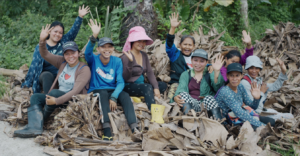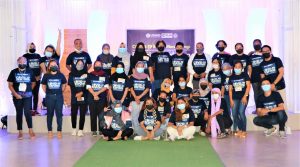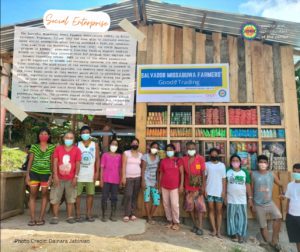This workshop is a vital component of the Indigenous Peoples Resilience Building Project (IPR Project), a broader initiative aimed at enhancing the socio-economic resilience and self-determination of Indigenous Peoples (IPs) in the Caraga Region.
Prosperidad, Agusan del Sur—Under the weight of mounting climate threats, a crucial assembly took place on September 16-17, 2024. At the Farmers Inn Hotel in Prosperidad, Agusan del Sur, community leaders, government officials, and environmental advocates gathered to chart a future where ancient Indigenous wisdom meets modern science. This wasn’t just another workshop on disaster preparedness—it was a pivotal moment in the fight for the survival of ancestral lands and cultures against the forces of climate change.
As typhoons become more frequent and floods more devastating, the Indigenous Manobo communities in the ancestral domains of CADT 117 and 090, located in La Paz and Loreto, are turning to their rich traditions for answers. The workshop, titled “Integrating Indigenous Knowledge Systems and Practices (IKSP) and Disaster Risk reduction (DRR) and Climate Change Adaptation (CCA) Measures in the ADSDPP of CADT 117 and 090 and Interfacing with LCCAP and LDRRM Plans of La Paz and Loreto,” was far from an academic exercise – it was a call to action. The stakes were clear: without a unified approach that honors both Indigenous knowledge and contemporary climate science, the future of these communities and their ancestral lands could be at risk.
A Guiding Light: The Ancestral Domain Sustainable Development and Protection Plan
The workshop participants, including barangay and local government representatives from La Paz and Loreto, committed to integrating these Indigenous practices into their Local Climate Change Action Plans (LCCAP) and Local Disaster Risk Reduction and Management (LDRRM) plans.
For the Manobo people, the Ancestral Domain Sustainable Development and Protection Plan (ADSDPP) is more than a document – it is a lifeline. Often referred to by community members as “a bible,” the ADSDPP serves as a guide for the preservation of their cultural heritage, environmental stewardship, and sustainable development. Grounded in Indigenous knowledge system and practices, the plan weaves together traditional wisdom and modern governance, offering a pathway for the community to thrive despite the escalating challenges posed by climate change.
This activity is a vital component of the Indigenous Peoples Resilience Building Project (IPR Project), a broader initiative aimed at enhancing the socio-economic resilience and self-determination of Indigenous Peoples (IPs) in the Caraga Region. The IPR Project focuses on strengthening Indigenous communities’ ability to manage their ancestral domains, engage with government agencies, and effectively respond to disaster risks while contributing to climate change adaptation. The project of ECOWEB is generously funded by Help Germany, BMZ-German Cooperation, and the German Relief Coalition (ADH), whose combined efforts have enabled the empowerment of Indigenous communities.
During the workshop, Indigenous Political Structure (IPS) leaders voiced out the significance of this integration. One leader expressed deep gratitude to ECOWEB for facilitating this collaboration. “Mapasalamaton kami sa ECOWEB sa paghatag ug espasyo ug suporta diha sa pagduso sa among katungod isip lumadnong komunidad ug paprotektar sa among yutang kabilin,” (“We are grateful to ECOWEB for providing us with this platform and supporting our rights as Indigenous communities, while also championing the protection of our ancestral domains.”) he said, thanking ECOWEB for its commitment to upholding Indigenous rights and protecting their ancestral lands. His words echoed the community’s hope that their ADSDPP would be fully realized, ensuring that future generations inherit not just the land, but the deep connection to it that sustains them.
Indigenous Political Structures on the Frontlines of Disaster Preparedness
The Indigenous Political Structure (IPS), comprised of traditional leaders who are custodians of Indigenous knowledge, called for formal representation within the local Disaster Risk Reduction and Management (DRRM) councils.
A core focus of the workshop was a proposal that could redefine the role of Indigenous communities in disaster management. The Indigenous Political Structure (IPS), comprised of traditional leaders who are custodians of Indigenous knowledge, called for formal representation within the local Disaster Risk Reduction and Management (DRRM) councils. This would give the IPS a seat at the table during critical decision-making processes, ensuring that the unique vulnerabilities and strengths of Indigenous communities are addressed in disaster response plans.
“Lahi ang gidala nga mga hisgutanan sa IPMR,” (“The matters brought up by the IPMR are different.”) explained Datu Ricky Mondejar, one of the clan leaders of CADT 117, contrasting the legislative focus of the Indigenous Peoples Mandatory Representative (IPMR) with the IPS’s emphasis on protecting ancestral lands. “Lahi ang IPS nga ang tumong mao ang yutang kabilin,” (“The IPS is different because its focus is the ancestral domain.”) he added. For Datu Ricky, the IPS’s mission transcends municipal boundaries, focusing on safeguarding the ancestral domain—a task that requires the inclusion of Indigenous leaders in disaster planning.
The inclusion of the IPS in local DRR councils is seen as essential to incorporating Indigenous Knowledge Systems and Practices (IKSP) into formal disaster preparedness frameworks. This move would ensure that disaster response strategies reflect the real-world experiences of those living on the front lines of environmental change. By integrating Indigenous early warning systems, such as monitoring animal behavior or shifts in plant growth, with modern technologies, the councils can craft a more comprehensive and culturally sensitive approach to disaster risk reduction.
Bridging Ancient Wisdom and Modern Governance
The partnership between the Indigenous communities and local governments marks a significant step toward a more inclusive and holistic approach to climate resilience.
At the heart of this initiative is the understanding that Indigenous knowledge, passed down through generations, offers vital tools for addressing the climate crisis. The traditional farming techniques of the Manobo people, including agroforestry and sustainable forest management, not only protect the environment but also provide resilience against climate change’s harshest impacts. These practices help prevent soil erosion, conserve biodiversity, and create natural buffers against floods and landslides—threats that are becoming increasingly common in Agusan del Sur.
The workshop participants, including barangay and local government representatives from La Paz and Loreto, committed to integrating these Indigenous practices into their Local Climate Change Action Plans (LCCAP) and Local Disaster Risk Reduction and Management (LDRRM) plans. This alignment ensures that local governments not only recognize the value of Indigenous knowledge but also embed it into the core of their disaster and climate strategies.
The partnership between the Indigenous communities and local governments marks a significant step toward a more inclusive and holistic approach to climate resilience. By ensuring that the ADSDPP and the IKSP are fully integrated into official planning frameworks, the communities of CADT 117 and 090 are building a stronger foundation for the future—one that respects both their cultural heritage and the need for climate adaptation.
Resilience Through Collaboration
Together, they are developing disaster preparedness strategies that are both practical and deeply rooted in the cultural identity of the Manobo people.
The workshop’s success lies in its ability to foster collaboration between Indigenous leaders and local authorities. Together, they are developing disaster preparedness strategies that are both practical and deeply rooted in the cultural identity of the Manobo people. This partnership is essential, especially as the impacts of climate change become more severe and unpredictable.
A key achievement of this collaboration is the commitment to reviewing all projects and plans in the ADSDPP for integration into the LCCAP and LDRRM plans of La Paz and Loreto. This will ensure that development efforts in the area are aligned with both Indigenous priorities and modern sustainability goals. The ADSDPP is not just a safeguard for the present—it is a roadmap for the future, designed to enhance the community’s resilience in the face of climate challenges.
A Shared Vision for the Future
“By integrating the priorities of Indigenous Peoples (IP) into the LGUs’ LCCAP and DRRM plans, and fostering a deeper understanding among IP leaders of the government’s climate resilience and DRRM framework, we facilitate a synergy of efforts,” remarked ECOWEB Executive Director, Regina Salvador – Antequisa.
As the workshop concluded, there was a palpable sense of hope. The Indigenous Political Structure (IPS) leaders had made their voices heard, and their knowledge had been recognized as essential to the region’s climate and disaster preparedness efforts. For the Manobo people, this represents not just progress, but empowerment.
“This activity is crucial for ensuring the sustainability of impact of the ECOWEB IP Resilience project. By integrating the priorities of Indigenous Peoples (IP) into the LGUs’ LCCAP and DRRM plans, and fostering a deeper understanding among IP leaders of the government’s climate resilience and DRRM framework, we facilitate a synergy of efforts. This approach ensures that the government supports the priorities of IP communities, strengthens their capacities, and promotes programs informed by indigenous knowledge and practices while aligning with appropriate government strategies for local implementation,” remarked ECOWEB Executive Director, Regina Salvador – Antequisa who co-facilitated the workshop. This sentiment encapsulates the essence of the workshop—that the future lies in unity, in a shared vision where the old and the new coexist to create a stronger, more resilient community.
As climate change continues to reshape the world, the lessons learned in the workshop may well serve as a model for other Indigenous communities and local governments striving to protect their people and lands. The integration of Indigenous Knowledge Systems and Practices into formal governance structures is more than just a strategy—it stands as a monument to the power of collaboration, culture, and resilience. | Kin Barkly Tibang & Hannah Mae Bertonia



